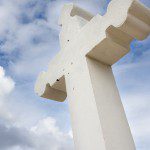Although the Early Church did not use the cross in the overt and casual way we use it today, they still incorporated it into their theology, liturgy, and identity. When people look at the cross today they generally think of Christianity as a religion. When the first followers of Jesus looked at the cross they thought of it as a place in space and time and a seal that marks people of faith. The way that this twofold understanding manifested itself in the life, theology and worship of the early church is essential to understanding how they viewed the work and death of Christ and the place that death had in their own lives.
The Place
The place of the cross was centered on the historical event of the crucifixion of Jesus. Christians and historians alike generally agree that Jesus was killed on an actual cross made from an actual tree. The cross was set up on a area that was called Golgotha, which was located just outside of a real city called Jerusalem. Jesus was hung on that cross at an actual time, and died on the cross at an actual time, which was around three in the afternoon according to Luke 23:44. As early Christians began to reflect on the historical reality of the cross they began to realize that the cross was a historical event that was so important that the it’s effects were still actively being experienced in their own lives. They believed that the cross spoke a word from God that, when received, could actually bring about salvation across all time.
The entire salvation event was seen as so connected to the historical cross that the Apostle Paul goes so far to point to the Gospel that he preached as a λόγος (word) that came from the cross itself. The historical cross was not just something that people looked to and remembered. It was seen as a active participant in the christian life. To be a christian meant to be united with Christ and the cross on which he was crucified. It is due to this understanding that Paul teaches that the cross is used in his own time, decades after the crucifixion, as an active force which reconciles Jews and Gentiles and a location upon which the χειρόγραφον (certificate of debt) recording transgressions is removed.
One of the Early fathers, Athanasius, saw the place of the cross is where the church is drawn into Christ.
In John’s Gospel Jesus declares that when he is “lifted up” he will draw all men to himself. Athanasius, and many other church fathers, belived that the place where Christ was lifted up was on the cross. They believed that on the cross Jesus made a way for all people to go to heaven. Athanasius was inspired by even the posture of Christ’s death. He states that,
“it is only on the cross that a man dies with his hands spread out. Whence it was fitting for the Lord to bear this also and to spread out His hands, that with the one He might draw the ancient people, and with the other those from the Gentiles, and unite both in Himself”(On the Incarnation, 25)
Even the very act of lifting Jesus was seen as having an effect on the cosmology of the spiritual realm. Athanasius points to Ephesians 2:2 as indicating that the air itself was a should be seen as a sphere of the devil, and that by Christ being lifted up into the air the Devil was overthrown and a way was made to heaven.













